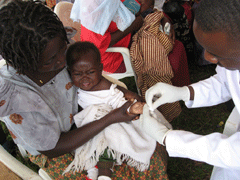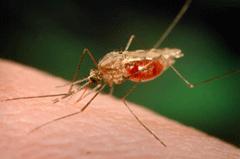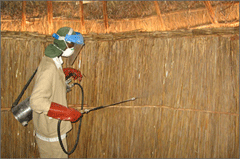Goodbye DDT
Air Date: Week of May 8, 2009
 |
Three years after endorsing the use of DDT in poor countries to control malaria, the World Health Organization is reversing its policy. The goal is to completely phase out the use of the toxic pesticide by 2020. Brenda Eskenazi, an epidemiologist at UC Berkeley, tells host Steve Curwood that mounting research on DDT's negative health effects helped convince public health officials to seek non-chemical alternatives to counter malaria.
Transcript
YOUNG: It’s Living on Earth, I’m Jeff Young –
CURWOOD: And I’m Steve Curwood.
The pesticide DDT has been banned in the developed world for years now. But the treaty known as the Stockholm convention does allow its use for malaria control – and it’s still widely applied in parts of Africa and Asia.
Well, that’s set to change, because the World Health Organization has reconsidered its 2006 endorsement of the malaria exception for DDT. The WHO is joining forces with the UN Environmental Program to completely phase out DDT worldwide by 2020.
Brenda Eskenazi thinks that's a good idea. She's an epidemiologist at the UC Berkeley School of Public Health, and has just completed a review of more than 500 studies on the pesticide and human health.
Dr. Eskenazi, what did you find - what health problems are associated with DDT?

A child is tested for malaria in Ruhiira, Uganda. Every year, nearly a million people die from malaria-- most are children in sub-Saharan Africa. (Courtesy of the Millennium Promise)
ESKENAZI: The studies that have come out have suggested that there are associations with breast cancer, there are associations with effects on the neurobehavioral development of children, there are associations with spontaneous abortion. And there are quite a number of studies that have looked at DDT and diabetes and found an association. But the most interesting work is work out of South Africa in a community where DDT was being used using indoor residual spraying where they actually spray the insides of the mud huts to prevent the mosquitoes from lodging on the walls. And they found that the men that lived there had a dose related decrease in semen quality. And it was very profound, but there are also very, very few studies that have been conducted in the communities where DDT is actively being used in the method its being used currently.
CURWOOD: And I gather in places where it’s used to fight malaria in buildings that people will have much higher body burdens of DDT than we typically see in the west.

DDT kills mosquitoes that carry malaria.
ESKENAZI: Way out of the range of what we see currently in the west. And even what we ever saw in terms of when DDT was used in the United States, partly because DDT is used specifically indoors in the African communities and so the huts are sprayed, people are not in the homes when they are sprayed, but their pots and pans and their beds and their children’s toys may still be in the homes. And then the families reenter the homes soon after the spraying, maybe the children are playing on the floor, maybe the children will put their hands in their mouths. So the levels that we’re likely to see are going to be so much higher than we probably would have seen in the way it had been used in the United States in the 1960s.
CURWOOD: What were the effects on humans here in the United States from the use of DDT?
ESKENAZI: Well, there’s a recent study that has just come out following up a cohort of women who were pregnant in the 1950s and 60s and they found that those women who were exposed to DDT before the age of 14 had something like a five fold increased risk for breast cancer now. And these are women who were exposed back in the 40s and the 50s and the 60s.
CURWOOD: What does it say for Asian and African women who might be getting exposed to DDT today?
ESKENAZI: I think that’s exactly the concern that we have. The concern is that we’re exposing a population to very, very high levels of DDT now, and we don’t know what’s going to happen to these women or these men in the future. So in the future we may see, maybe twenty years down the road an increase in breast cancer in these populations, we may see a decrease in fertility sooner in time, but we have a good potential to see something based on the literature that we reviewed.

Scientists worry about the health risks posed by the indoor spraying of DDT. (Courtesy of the World Health Organization)
CURWOOD: In 2006, the U.S. was part of an initiative with the World Health Organization to really increase the use of DDT to fight malaria. In your view, how appropriate was that?
ESKENAZI: I think that it was not based on good sound science. I think that maybe DDT was an important way to curtail malaria, but we hadn’t don the research necessary to know whether other adverse effects are happening from that policy. For example, we have no idea what happens to the populations that are immunocompromised that are living in Africa. Where much of the malaria is high is also the same areas where HIV are high. We have no idea how those people are specifically affected by DDT.
CURWOOD: Why do you think the World Health Organization, the WHO, is changing its views on this?
ESKENAZI: Well, I think that the World Health Organization now is going back to the Stockholm Convention as it was intended, which is that DDT can be used, but it needs to be phased out. And it seems that UNF and WHO are endorsing and funding efforts that would allow replacement of DDT in the communities that couldn’t afford to do anything else, and that’s why DDT was in part being used, it was relatively cheap and it was easy. But there are better ways, for example, draining pools of standing water, using different kinds of plants to repel mosquito larva and by clearing vegetation. So there are other things that can be done. And that is where we have to help these communities so that they can step away from use of DDT.
CURWOOD: Brenda Eskenazi is a professor at the University of California Berkeley School of Public Health. Thank you so much, Dr. Eskenazi.
ESKENAZI: Thank you so much.
Links
Living on Earth wants to hear from you!
Living on Earth
62 Calef Highway, Suite 212
Lee, NH 03861
Telephone: 617-287-4121
E-mail: comments@loe.org
Newsletter [Click here]
Donate to Living on Earth!
Living on Earth is an independent media program and relies entirely on contributions from listeners and institutions supporting public service. Please donate now to preserve an independent environmental voice.
NewsletterLiving on Earth offers a weekly delivery of the show's rundown to your mailbox. Sign up for our newsletter today!
 Sailors For The Sea: Be the change you want to sea.
Sailors For The Sea: Be the change you want to sea.
 The Grantham Foundation for the Protection of the Environment: Committed to protecting and improving the health of the global environment.
The Grantham Foundation for the Protection of the Environment: Committed to protecting and improving the health of the global environment.
 Contribute to Living on Earth and receive, as our gift to you, an archival print of one of Mark Seth Lender's extraordinary wildlife photographs. Follow the link to see Mark's current collection of photographs.
Contribute to Living on Earth and receive, as our gift to you, an archival print of one of Mark Seth Lender's extraordinary wildlife photographs. Follow the link to see Mark's current collection of photographs.
 Buy a signed copy of Mark Seth Lender's book Smeagull the Seagull & support Living on Earth
Buy a signed copy of Mark Seth Lender's book Smeagull the Seagull & support Living on Earth

